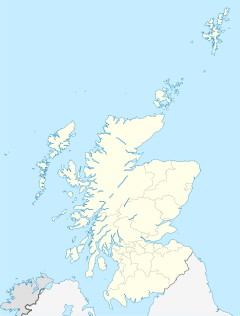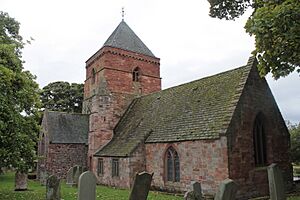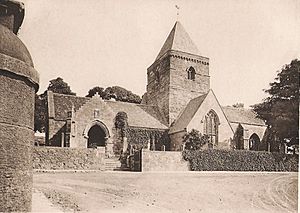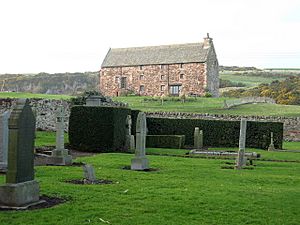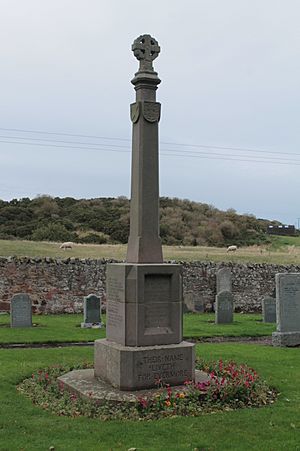Whitekirk facts for kids
Quick facts for kids Whitekirk |
|
|---|---|
| OS grid reference | NT596815 |
| Council area |
|
| Lieutenancy area | |
| Country | Scotland |
| Sovereign state | United Kingdom |
| Post town | Dunbar |
| Postcode district | EH42 |
| Dialling code | 01620 870xxx |
| Ambulance | Scottish |
| EU Parliament | Scotland |
| UK Parliament |
|
| Scottish Parliament |
|
Whitekirk is a small village located in East Lothian, Scotland. It shares its name with the nearby village of Tyninghame to form the local area known as Whitekirk and Tyninghame.
Contents
Discovering Whitekirk's History
Whitekirk is about 4 miles (6.4 km) from North Berwick, 8 miles (12.9 km) from Dunbar, and 25 miles (40.2 km) east of Edinburgh. This place has been important for Christian worship for a very long time. It was once known as Hwīt Cirice, which means "White Church" in Old English, because of the original color of its church.
The village had a special holy well dedicated to St Mary the Virgin, though it's now lost. There was also a famous statue called Our Lady of Haddington. Whitekirk was a popular stop for pilgrims traveling from St Andrews in Scotland all the way to Santiago de Compostela in Spain. This journey was even mentioned in an old travel guide for pilgrims!
Sadly, in 1356, the shrine of Our Lady at Whitekirk was damaged by the armies of Edward III of England. This period was known as the Burnt Candlemas, a time of much destruction. Later in the 14th century, a new shrine to Our Lady was created at the Church of St. Mary the Virgin in Haddington.
Even after this, Whitekirk remained a significant place for pilgrims. Many important people visited, including Pope Pius II (who would later become Pope), King James IV, Margaret Tudor (King James IV's wife), and King James V.
Famous Visitors and Events
In early 1435, Aeneas Piccolomini (who became Pope Pius II) was on a diplomatic trip to Scotland. His ship faced terrible storms. After praying to Our Lady, his ship safely reached Dunbar. He had promised to walk barefoot to the nearest shrine if he survived, so he walked eight miles through the freezing countryside to Whitekirk. This difficult walk caused him to suffer from rheumatism (joint pain) for the rest of his life!
King James IV visited Whitekirk from Dunbar in May 1497. He left money to help the poor and those with leprosy. Later, in 1678, the Covenanting preacher John Blackadder held his last outdoor religious meeting (called a conventicle) on the hill behind the church.
The Tithe Barn and Holy Well
The building known as the tithe barn might have been rebuilt in the 16th century as a hostel for pilgrims. Another idea is that it was a tower built by Oliver Sinclair before becoming a tithe barn in the 17th century. A tithe barn was a place where farmers stored a portion of their crops or produce as a payment to the church. Today, this historic building is a Bed & Breakfast.
The Holy Well, which was a source of sacred water, dried up in the 1800s because of changes in farming drainage. It is believed to be located close to the church building.
The Church Building Today
The current church was last restored in 2005–2006. In 1914, the church was set on fire. It was thought to be done by suffragette campaigners, who fought for women's right to vote, but this was never proven. The church was beautifully restored by the office of Sir Robert Lorimer, a famous architect. Sir Robert Lorimer also designed the village's war memorial in 1920.
The church is now the red color of its natural sandstone, but it got its name "Whitekirk" from its original white appearance. From 1806 to 1852, the minister of Whitekirk was the Reverend James Wallace. He held the highest position in the Church of Scotland as the Moderator of the General Assembly in 1831-1832. He lived in the manse, which is the minister's house, built in 1796.
The Whitekirk Pilgrimage
Since 1971, on the second Saturday of May each year, there has been an ecumenical pilgrimage starting at Whitekirk and ending in Haddington. An ecumenical pilgrimage means people from different Christian churches walk together. This walk was started by Patrick Maitland, the 17th Earl of Lauderdale. The number of people joining grew from about 30 in the early 1970s to over 2,000! However, in 2008, the pilgrimage was cancelled because not enough people signed up.
See also
- List of places in East Lothian
- Canty Bay


